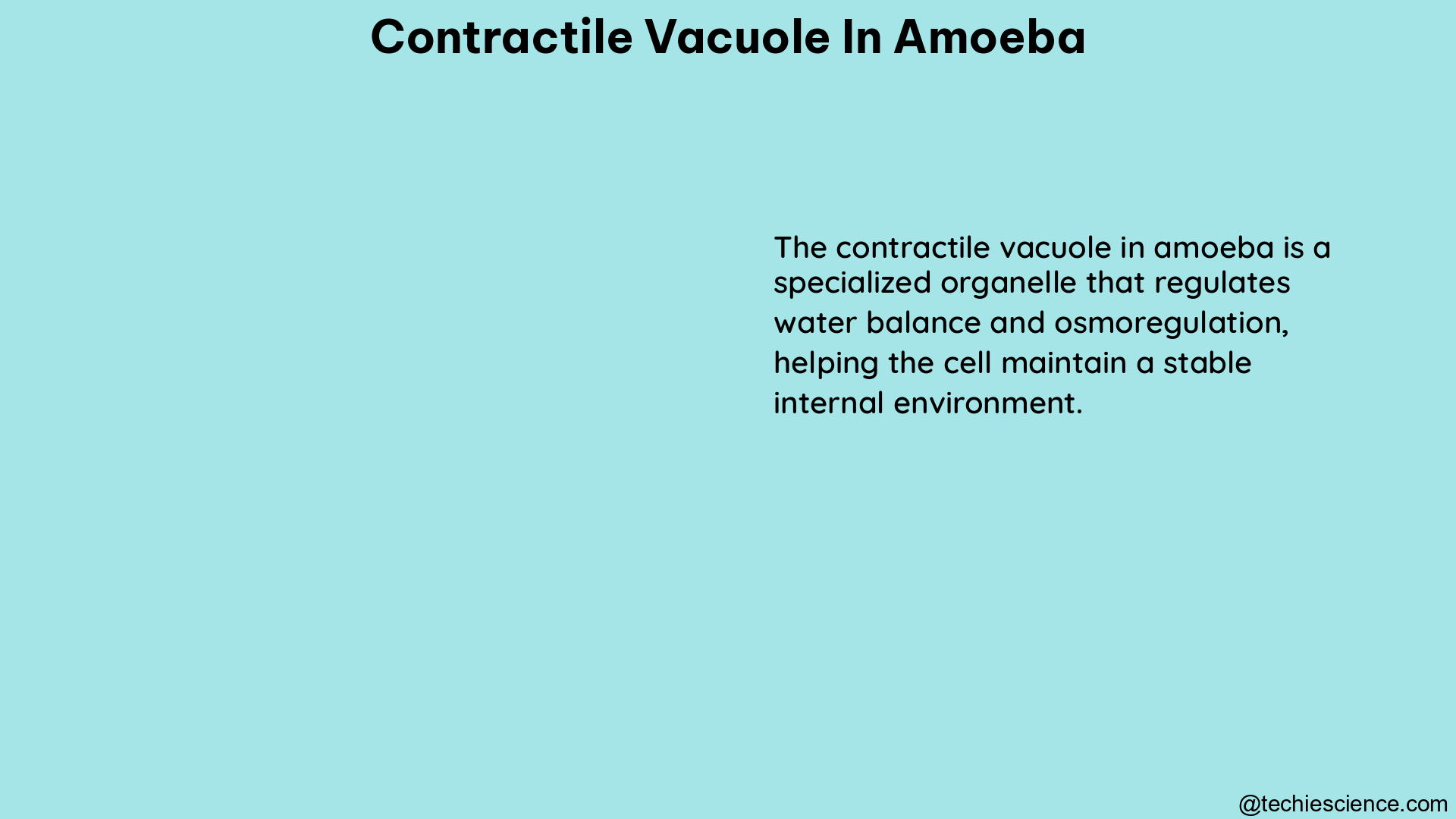Contractile vacuoles in amoeba are specialized organelles that play a crucial role in the maintenance of water and solute balance within the cell, a process known as osmoregulation. These remarkable structures function by collecting excess water from the cytosol and actively pumping it out of the cell, preventing the amoeba from swelling and bursting in hypo-osmotic environments.
Understanding the Pumping Mechanism
The rate of water elimination by amoebae living and reproducing in various concentrations of seawater has been extensively studied. According to a study published in the Journal of Experimental Biology, the pumping rate and maximum contractile vacuole area were quantified in five cells per experimental replicate. The results revealed that amoebae exhibit a remarkable ability to adapt to changes in their osmotic environment, adjusting their contractile vacuole activity accordingly.
Molecular Mechanisms of Contractile Vacuole Function

In the case of the amoeba species Amoeba proteus, researchers have identified the presence of two key players on the contractile vacuole membrane: aquaporins and V-ATPases. Aquaporins are specialized proteins that facilitate the transport of water across cell membranes, while V-ATPases are proton pumps that generate a proton gradient, which can be used to drive other secondary transport processes.
The role of aquaporins in contractile vacuole function has been further elucidated in the unicellular alga Chlamydomonas reinhardtii. In this organism, the aquaporin major intrinsic protein 1 (MIP1) is localized to the contractile vacuole and is responsible for facilitating the flux of water into the vacuole. Interestingly, the expression rate and protein level of MIP1 exhibit only minor fluctuations under different osmotic conditions, suggesting that the regulation of contractile vacuole size and contraction interval is a complex process involving multiple mechanisms.
Quantifying Contractile Vacuole Properties
Researchers have been able to measure and quantify various properties of contractile vacuoles in amoeba, providing valuable insights into their function and regulation. Some of the key parameters that have been studied include:
-
Pumping Rate: The rate at which the contractile vacuole eliminates excess water from the cell, measured in terms of the volume of water pumped out per unit time.
-
Maximum Contractile Vacuole Area: The maximum size or volume that the contractile vacuole can attain before it contracts and expels the water.
-
Contraction Interval: The time between successive contractions of the contractile vacuole, which can vary depending on the osmotic strength of the medium.
These quantifiable properties not only help us understand the underlying mechanisms of osmoregulation in amoeba but also provide a framework for comparing the contractile vacuole function across different species and environmental conditions.
Regulation of Contractile Vacuole Size and Activity
The regulation of contractile vacuole size and activity in amoeba is a complex process that involves multiple factors. In the unicellular alga Chlamydomonas reinhardtii, for example, the size of the contractile vacuoles increases during cell growth, while the contraction interval strongly depends on the osmotic strength of the medium.
The presence of aquaporins, such as MIP1 in Chlamydomonas reinhardtii, plays a crucial role in regulating water flux into the contractile vacuole. Interestingly, the expression rate and protein level of MIP1 exhibit only minor fluctuations under different osmotic conditions, suggesting that the regulation of contractile vacuole size and contraction interval involves additional mechanisms beyond just aquaporin activity.
Comparative Analysis of Contractile Vacuole Function
While the contractile vacuole is a common feature among many protists, including amoeba, its structure and function can vary across different species. For instance, in the amoeba Amoeba proteus, the presence of aquaporins and V-ATPases on the contractile vacuole membrane has been well-documented, as mentioned earlier.
In contrast, the contractile vacuole of the ciliate Paramecium has a more complex structure, with a network of interconnected tubules and sacs. These structures are believed to play a role in the rapid expulsion of water, as well as the regulation of intracellular pH and ion homeostasis.
Comparative studies of contractile vacuole function across different protist species can provide valuable insights into the evolutionary adaptations and the diverse strategies employed by these organisms to maintain water and solute balance in their respective environments.
Conclusion
Contractile vacuoles in amoeba are remarkable organelles that play a crucial role in the osmoregulation of these unicellular organisms. Through the active pumping of excess water out of the cell, contractile vacuoles prevent amoebae from swelling and bursting in hypo-osmotic environments.
The detailed understanding of the molecular mechanisms, quantifiable properties, and regulatory mechanisms underlying contractile vacuole function in amoeba has been made possible through extensive research. These findings not only contribute to our knowledge of protist biology but also have broader implications in the field of cell biology and evolutionary adaptations.
As we continue to explore the fascinating world of contractile vacuoles in amoeba, we can expect to uncover even more insights into the intricate strategies employed by these remarkable organisms to thrive in diverse aquatic environments.
References:
– Roos, A., & Boron, W. F. (1981). Intracellular pH. Physiological reviews, 61(2), 296-434.
– Nishihara, E., Yokota, E., Tazawa, M., & Miyoshi, S. (1999). Vacuolar H+-ATPase in the contractile vacuole complex of Chlamydomonas reinhardtii. The Journal of experimental biology, 202(22), 3195-3204.
– Hardt, H., & Plattner, H. (1999). Quantitative analysis of contractile vacuole dynamics in Paramecium by video microscopy and computer-assisted image processing. European Journal of Protistology, 35(3), 279-289.
– Nishihara, E., Yokota, E., Tazawa, M., & Miyoshi, S. (1999). Vacuolar H+-ATPase in the contractile vacuole complex of Chlamydomonas reinhardtii. The Journal of experimental biology, 202(22), 3195-3204.

Hello, I am Bhairavi Rathod, I have completed my Master’s in Biotechnology and qualified ICAR NET 2021 in Agricultural Biotechnology. My area of specialization is Integrated Biotechnology. I have the experience to teach and write very complex things in a simple way for learners.